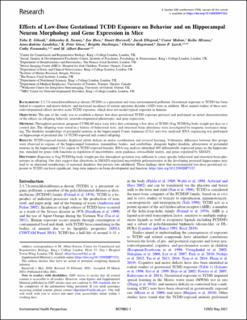| dc.contributor.author | Gileadi, Talia E. | |
| dc.contributor.author | Swamy, Abhyuday K. | |
| dc.contributor.author | Hore, Zoe | |
| dc.contributor.author | Horswell, Stuart | |
| dc.contributor.author | Ellegood, Jacob | |
| dc.contributor.author | Mohan, Conor | |
| dc.contributor.author | Mizuno, Keiko | |
| dc.contributor.author | Lundebye, Anne-Katrine | |
| dc.contributor.author | Peter Giese, Giese | |
| dc.contributor.author | Stockinger, Brigitta | |
| dc.contributor.author | Hogstrand, Christer | |
| dc.contributor.author | Lerch, Jason P. | |
| dc.contributor.author | Fernandes, Cathy | |
| dc.contributor.author | Albert Basson, Basson | |
| dc.date.accessioned | 2022-03-09T11:35:23Z | |
| dc.date.available | 2022-03-09T11:35:23Z | |
| dc.date.created | 2022-02-15T17:25:22Z | |
| dc.date.issued | 2021 | |
| dc.identifier.citation | Environmental Health Perspectives. 2021, 129 (5), . | en_US |
| dc.identifier.issn | 0091-6765 | |
| dc.identifier.uri | https://hdl.handle.net/11250/2983982 | |
| dc.description.abstract | 2,3,7,8-tetrachlorodibenzo-p-dioxin (TCDD) is a persistent and toxic environmental pollutant. Gestational exposure to TCDD has been linked to cognitive and motor deficits, and increased incidence of autism spectrum disorder (ASD) traits in children. Most animal studies of these neurodevelopmental effects involve acute TCDD exposure, which does not model typical exposure in humans. | en_US |
| dc.language.iso | eng | en_US |
| dc.title | Effects of low-dose gestational tcdd exposure on behavior and on hippocampal neuron morphology and gene expression in mice | en_US |
| dc.type | Peer reviewed | en_US |
| dc.type | Journal article | en_US |
| dc.description.version | publishedVersion | en_US |
| dc.source.pagenumber | 0 | en_US |
| dc.source.volume | 129 | en_US |
| dc.source.journal | Environmental Health Perspectives | en_US |
| dc.source.issue | 5 | en_US |
| dc.identifier.doi | 10.1289/EHP7352 | |
| dc.identifier.cristin | 2002000 | |
| cristin.ispublished | true | |
| cristin.fulltext | original | |
| cristin.qualitycode | 2 | |
